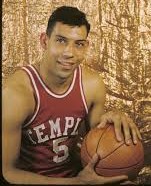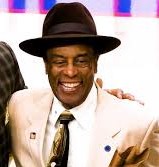There have been a lot of great basketball players to come out of the City of Brotherly Love but Guy Rodgers has to be considered 1 of the best. During college he helped lead Temple to a 3rd-place postseason finish for 3 straight years (1956 NCAA Tournament/1957 NIT/1958 NCAA Tournament) before graduating as the school’s all-time leading scorer with 1767 career PTS. After becoming a territorial pick of the Philadelphia Warriors in the 1958 NBA draft he later tied Bob Cousy’s record of 28 assists in a single game in 1963 and was named an All-Star 4 times in a 5-year span from 1963-1967. He died in 2001 and was posthumously inducted into the Hall of Fame in 2014. HoopsHD’s Jon Teitel got to chat with another Philadelphia legend named Sonny Hill (who has spent more than 50 years in broadcasting, including 30+years with his own radio show on WIP) about Guy’s amazing career in both college and the NBA. Today marks the 20th anniversary of Guy’s passing on February 19, 2001 so we are proud to reflect on his life and legacy.
Rodgers scored 18.5 PPG in his 1st year on the varsity squad at Temple: how was he able to come in and contribute right from the start? Back then there was a rule that freshmen could not play so he only had 3 years of college eligibility. Guy was so good and so far ahead of the game that he could have started at any college in the country even when he was a high school junior. He could handle the ball and had a great basketball IQ so he was more than equipped to do what he did as a sophomore.
In the 1956 Final 4 he scored 28 PTS and tourney MOP Hal Lear scored 32 PTS in a 7-PT loss to Iowa: where does that Owl backcourt rank among the greatest in college basketball history? There is no college backcourt at the level of Hal Lear/Guy Rodgers. Hal set an NCAA tourney record in 1956 when he scored 48 PTS in a 9-PT win over SMU in the 3rd-place game. Guy was the quintessential dribbler/ball-handler. They were both left-handed and quick as a hiccup so they were the ideal combination. The only other comparable college basketball backcourt was Walt Hazzard/Gail Goodrich during the early-1960s at UCLA, who helped lead the Bruins to an undefeated NCAA title in 1964. Walt came from Overbrook High School in Philadelphia and helped put UCLA on the map. Walt was raised by Guy and mentored by Hal, who was a few years ahead of him at Overbrook.
In the 1958 Final 4 he scored 22 PTS in a 1-PT loss to Kentucky: how much of a home-court advantage did the Wildcats have while playing in Louisville, and do you think that Temple would have won the game if his back was healthy? They stole the ball game because of what you said. Kentucky was 1 of the premier teams in the country and the Temple players were dealing with the effects of racism and were treated as 2nd-class citizens. The burden of the environment led to the referees’ calls favoring the Wildcats rather than having a fair game. Guy/Hal were called the “Dusty Twins” due to being a pair of Black players.
He was a 2-time All-American: what did it mean to him to receive such outstanding honors? He appreciated the fact that he could get the recognition but he was so assured of his abilities that it was normal for him to be a dominant player who had a tremendous impact on how the game was being played. Prior to Guy/Hal and other players of the early 1950s there was not a great influx of Black players, and those who came into the NCAA had to deal with the good-old-boy network if they wanted to get onto the floor. Think about how many Black players were given an opportunity to blossom thanks to Coach Harry Litwack at Temple. They were allowed to play the Black game with a little pizazz rather than the mundane White game of passing the ball 3-4 times before trying to score. The Black players brought speed/excitement to the White colleges, where they finally got the recognition despite the good-old-boy network of White coaches.
He scored 11 PTS and had a game-high 20 AST during Wilt Chamberlain’s 100-PT game in March 1962 as the Warriors beat the Knicks 169-147: do you think that Wilt would have been able to hit the century mark without Rodgers’ help? Guy was drafted by the Warriors in 1958 and Wilt was drafted the following year in 1959. Most players did not know how to pass the ball to Wilt: they would pass it to his feet even though he was 7’1”! Guy was Wilt’s mentor so he knew how to throw the ball to him up high. Wilt would get a rebound, pass to Guy while he sped down the floor, and then receive a pass for an alley-oop.
In Game 7 of the 1962 Eastern Division Finals he scored 18 PTS but Sam Jones scored 28 PTS including the series-winning shot with 2 seconds left in a 2-PT win by Boston, and in the 1964 NBA Finals as a member of the San Francisco Warriors he lost to the Celtics in 5 games: was he frustrated to keep making deep runs in the playoffs only to run into the Celtics dynasty over and over? Yes: it was not only Guy but also his teammates such as Paul Arizin/Tom Gola. Nobody else could get by Boston back then so it was just a matter of trying to beat a team that was so well put together by Red Auerbach. Red was ahead of his time in opening the door and letting the Black players in (like Bill Russell). St. Louis owner Ben Kerner did not want a Black player so he traded Russell for Cliff Hagan/Ed Macauley.
He played for a pair of great coaches in Harry Litwack (college)/Alex Hannum (NBA): how were these fellow Hall of Famers able to get the most out of him? If we discuss the best all-time players both physically/mentally it would have to be Guy. He did not need coaches to motivate him but simply support him and allow him to play his game. Harry probably did not let Guy play his total game and use all of the tricks in his bag. Guy grew up when the Harlem Globetrotters were very famous. I played against Marques Haynes (who was the greatest dribbler ever) but Guy did not want to be accused of playing “Globetrotter basketball” so he reserved himself to a large degree. As a White player Bob Cousy could dribble behind his back and get away with it, even though he was just emulating what Haynes was already doing. It was different for Black players so Guy would submerge the things that he did in the schoolyard. Guy could come down the floor, wrap it around his back, and use his fist to punch the ball to a teammate for a layup. He was a great innovator and an extraordinary dribbler. He had tremendous reflexes: if you dropped a dollar bill between his thumb/finger he could catch it before it hit the ground. Pete Maravich emulated the Globetrotters and wanted to be the 1st White Globetrotter but they never accused him of putting on a show.
He led the NBA in AST in 1963/1967, finished 2nd in the league 6 other times, and his 7.8 career APG remains in the top-20 all-time: what made him such a great PG? He saw the game 2 plays ahead of everybody else, whereas most players are only 1 play ahead. I never remember him turning the ball over: I have asked other people the same question and they do not remember him doing that either. When guys like Bob Davies/Oscar Robertson made a pass it led directly to a layup, and John Stockton would get a lot of AST by passing to guys who would make jump shots. Pure assists were the old version. Harvey Pollack was 1 of the greatest statisticians ever: he told me that he went to games at the Boston Garden and watched the official scorers pad Cousy’s AST numbers/Russell’s REB numbers. You have to be careful when you talk about stats and how they are calculated: they are so liberal today. Nate “Tiny” Archibald is 1 of the quickest guards in the history of the sport: I asked him once who could bring the ball up the fastest and with no hesitation he said it was Guy.
In 2014 he was posthumously inducted into the Hall of Fame: how proud were you to see him get inducted? I was in the forefront of the hypocrisy that he was not inducted previously. I lobbied for many many years until his nomination finally went to the Old-Timers Committee.
When people look back on his career, how do you think that he should be remembered the most? I had Oscar on my radio show once and asked him who was the best passer/dribbler/ball-handler that he had ever seen. He does not give it up easily but without hesitation he said Guy. The only player in the history of the Big 5 to be inducted into the Hall of Fame as a player is Guy. The Big 5 was formed in 1956, which was after Arizin/Gola played in college.


